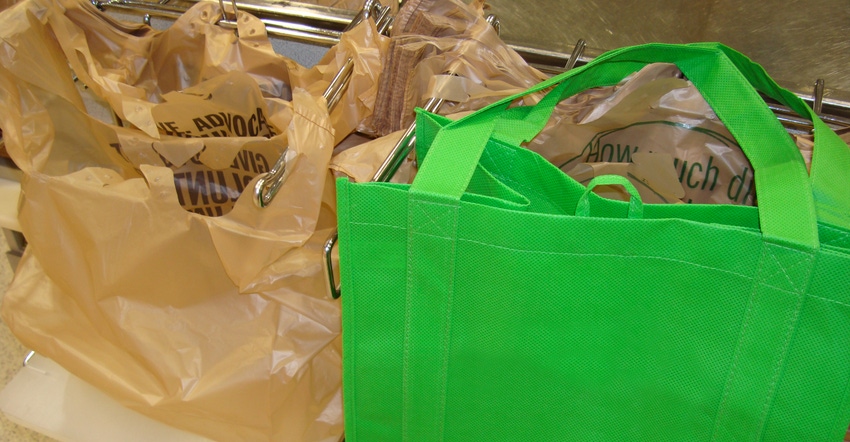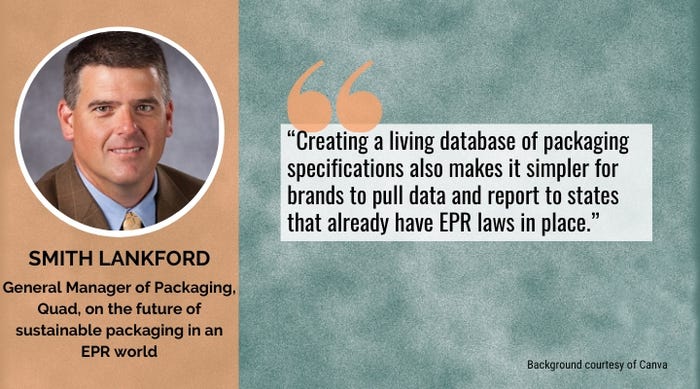The Future of Sustainable Packaging in an EPR World
Brands must anticipate and embrace extended producer responsibility (EPR) policies to stay competitive and do the right thing for the planet.

As children, we are taught not to judge a book by its cover. However, anyone in packaging design will tell you consumers judge a product by its package and label all the time. As sustainability packaging and design trends evolve, it can be difficult for retailers to adjust their own brands to keep pace while maintaining the look and feel needed to attract consumer attention.
But soon they may not have a choice.
Extended producer responsibility (EPR) programs are emerging in various states across the country to make producers financially and legally responsible for a product’s entire lifecycle. The objective is to minimize the product’s environmental impact. These policies seek to ensure product and packaging manufacturers — including retailers with their own brands — are incorporating recycling, adopting recyclable and recycled materials into their package design, and introducing other sustainable practices into their production process.
Maine was the first state to enact EPR legislation, passing An Act to Support and Improve Municipal Recycling Programs and Save Taxpayer Money in 2021. The law aims to push packaging producers to incorporate more recyclable material and reduce waste, shifting the responsibility for managing packaging waste from citizens and local governments to manufacturers. California, Colorado, Oregon, New Jersey, and Washington also have active EPR policies in place.
New York is currently considering legislation that will ensure alcohol producers take responsibility for their carbon footprints. Although the bill is currently in committee and has not yet reached the Senate floor for a vote, the Packaging Reduction and Recycling Infrastructure Act would require producers in New York State’s alcoholic drink industry, including breweries and wineries, to accept environmental responsibility for their product packaging by working to reduce packaging material and financially contribute to municipal recycling programs
Sustainability trends in retail.
Retailers around the country, though, are not waiting for formal legislation to address sustainability. They know their shoppers expect a higher level of attention to be paid to the impact they have on the environment and overall ecosystem, and many retailers have committed to progressively reducing the amount of plastic used in their stores in anticipation of EPR policies emerging across the country.
Retailers are also increasing use of sustainable materials and recycling options for their own-brand products, and they are emphasizing compliance with environmental laws and regulations. Responsible procurement and sourcing of materials will become a vital practice for retailers to help reduce their material waste.
As retailers adopt more sustainable practices, marketers will benefit from communicating about those actions. The Federal Trade Commission Green Guides provide direction on how to avoid greenwashing and misleading consumers with their environmental claims. They outline general principles for marketing statements, how consumers will likely interpret the statements and how brands and retailers can avoid accidentally deceiving consumers. For example, a packaged product could possibly deceive a consumer by being labeled as “recyclable” without clarifying if the product, the packaging, or both can be recycled.
During revision periods, the FTC takes suggestions and comments from the industry to update and enhance the guidelines. The most recent comment period closed in April 2023, and the revised Green Guides have not yet been released. The FTC previously updated the guidelines in 1996, 1998, and 2012. Brands can take advantage of future revision opportunities to communicate their experiences and views about recycling to the FTC.
As brands feel pressure from state governments to reduce their packaging material waste, it’s important for all producers to begin exploring sustainable packaging options and comply with local jurisdictions.
Moving the needle.
When it comes to sustainable innovations, California is the trendsetter. Just last year, California took a bold step in environmental advocacy by establishing a ban of the sale of gasoline-powered cars by 2035. This effort to reduce greenhouse gas emissions is leading the charge for more environmental legislation to follow.
California has also become the trailblazer in EPR legislation. The state recently imposed the most sweeping EPR law in the country, SB 54 The Plastic Pollution Prevention and Packaging Producer Responsibility Act, implementing strict plastic reduction and recycling mandates. The new legislation requires all packing material in California to be recyclable or compostable by 2032.
Instead of being the targets of EPR policies, brands ought to be a part of the legislative process. The public policy debate will be significantly improved when more brands share their perspectives on what is achievable, cost effective, and impactful with respect to EPR laws.
Brands are well positioned to be more socially responsible. Today’s consumers are searching out more sustainable products, and there is market share to be earned by embracing more eco-friendly products and investing in innovative solutions, particularly in the packaging space. The long-term compliance required by EPR policies can be a competitive advantage if approached thoughtfully. Being a leader in sustainable packaging will enhance brand awareness and brand loyalty from consumers who increasingly demand products with smaller environmental footprints that they can feel good about supporting.
Building a blueprint for EPR success.
However, success requires more than just initiative. It requires a team, new resources, and a road map. Brands should seek eco-friendly and sustainable packaging solutions that are as economical as they are sustainable — and use quantitative and qualitative consumer research to redesign their packaging to remain visually appealing to shoppers.
Of course, changes to packaging will not occur in isolation and are likely to affect supply chains. To ease and speed up the transition toward innovative packaging, brands should prioritize communication and collaboration with supply chain partners. Strengthened supply chain relationships will be critical for brands to research the materials that will be readily available and meet their sustainable packaging standards without adversely affecting their bottom line.
Success in embracing EPR legislation also requires brands to band together in a common effort to be responsible for their products beyond the consumer-use stage. As consumers become more aware of sustainable packaging and its impact on the environment, audience support will increase for brands that adopt environmentally conscious practices and actually do as they say to protect the planet.

Brands that measure and record the packaging specifications for their products will be able to demonstrate their progress more easily to their customers. Quantifying and comparing packaging’s environmental impacts can guide brands in making future choices that are increasingly sustainable. Creating a living database of packaging specifications also makes it simpler for brands to pull data and report to states that already have EPR laws in place.
Moving forward, brands need to be prepared. As more states develop and enact EPR laws, brands will have to take on more responsibility for the lifecycle of the products in their portfolios. Lawmakers are beginning to enforce business exploration and adaptation of sustainable packaging, as can be observed in New York with alcoholic beverage manufacturers.
The sooner brands move toward more sustainable packaging, the less likely it is that the government will feel the need to enact more draconian laws compelling action in this space. Brands can lead the way and inform laws that are effective and achievable while helping ensure their products are part of a brighter future for consumers and the environment.
Smith Lankford is the general manager of Quad's packaging division, which has operations in the U.S., Latin America, and Asia. In 2009, Smith was a partner in a group that purchased Copac Inc. in Spartanburg, S.C., and served as Chief Financial Officer. After Quad acquired Copac, Smith was named group controller for Packaging. He became general manager for Quad Packaging in April 2016.
About the Author(s)
You May Also Like




